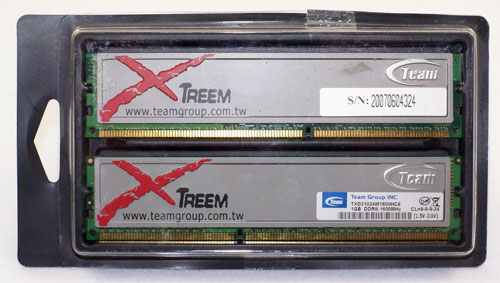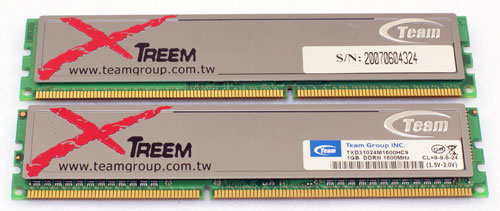Super Talent & TEAM: DDR3-1600 Is Here!
by Wesley Fink on July 20, 2007 11:30 AM EST- Posted in
- Memory
TEAM Xtreem DDRIII 1600MHz
TEAM Group, Inc. was established in Taiwan in 1994 as a manufacturer and wholesaler of computer components. TEAM is a company with a worldwide presence in memory modules, flash memory cards, and USB flash drives. All manufacturing is in Asia, but TEAM has US Sales and Marketing offices. Distribution is handled by centers in Taiwan, Hong Kong, and the USA, and TEAM plans additional distribution centers for the future. TEAM products have performed well in past memory reviews at AnandTech, and the TEAM DDR3-1600 memory caused quite a stir when it was demonstrated at Computex last month.

The form factor for the new TEAM DDR3-1666 is the now familiar Xtreem packaging. TEAM, like Kingston, continues to use the smaller two-piece memory box for their memory. The heatspreaders, however, are three-dimensional and loudly proclaim that the memory is Xtreem.

The DIMMs are single-sided, like the Super Talent DIMMs, but TEAM decided to mount memory heatsinks on both sides of the DIMM. The new DDR3-1600 is marketed as part of the top-of-the-line Xtreem series as you would expect from some of the fastest DDR3 memory you can currently buy.
Where Super Talent rates their Z9 Micron chip DIMMs at 7-7-7 timings, TEAM chooses the more conservative 9-9-9-24. If the specifications look a little strange, recall that DDR3 is generally lower voltage, higher speed, and slower timings than DDR2.
We do not yet have information on what configuration TEAM will market in DDR3 parts or the expected street prices for this memory. In the past TEAM has usually been one of the better values in each speed class where its memory competes. We would expect these DIMMs to be similarly priced.
TEAM Group, Inc. was established in Taiwan in 1994 as a manufacturer and wholesaler of computer components. TEAM is a company with a worldwide presence in memory modules, flash memory cards, and USB flash drives. All manufacturing is in Asia, but TEAM has US Sales and Marketing offices. Distribution is handled by centers in Taiwan, Hong Kong, and the USA, and TEAM plans additional distribution centers for the future. TEAM products have performed well in past memory reviews at AnandTech, and the TEAM DDR3-1600 memory caused quite a stir when it was demonstrated at Computex last month.

The form factor for the new TEAM DDR3-1666 is the now familiar Xtreem packaging. TEAM, like Kingston, continues to use the smaller two-piece memory box for their memory. The heatspreaders, however, are three-dimensional and loudly proclaim that the memory is Xtreem.

The DIMMs are single-sided, like the Super Talent DIMMs, but TEAM decided to mount memory heatsinks on both sides of the DIMM. The new DDR3-1600 is marketed as part of the top-of-the-line Xtreem series as you would expect from some of the fastest DDR3 memory you can currently buy.
| TEAM TXD31924M1600HC9 Memory Specifications |
|
| Number of DIMMs & Banks | 2 SS |
| DIMM Size | 1GB |
| Total Memory | 2 GB (2 x 1GB) |
| Rated Timings | 9-9-9--24 at DDR3-1600 |
| Rated Voltage | 1.5V to 2.0V |
Where Super Talent rates their Z9 Micron chip DIMMs at 7-7-7 timings, TEAM chooses the more conservative 9-9-9-24. If the specifications look a little strange, recall that DDR3 is generally lower voltage, higher speed, and slower timings than DDR2.
We do not yet have information on what configuration TEAM will market in DDR3 parts or the expected street prices for this memory. In the past TEAM has usually been one of the better values in each speed class where its memory competes. We would expect these DIMMs to be similarly priced.










31 Comments
View All Comments
Wesley Fink - Friday, July 20, 2007 - link
1333 and 1066 are both at 2.66GHz - which was the best we could do. We would definitely prefer to compare ALL memory speeds at the same CPU frequency as we have done in all memory testing in the past. However, as we point out in the article, with just a 1333 strap and a 333 multiplier it just isn't possible. With boards with 1600.166 and possibly 2000 atraps we can do fixed CPU speed and varied memory speed again.Suggestions for test speeds are welcomed.
rjm55 - Friday, July 20, 2007 - link
I can see where a 1600 strap is now almost a must on motherboards with these new 1600 kits. Does anyone know of ANY Intel P35 motherboard that has support for the 1600 or 1666 strap?LTG - Friday, July 20, 2007 - link
Please cite an example of "break though performance".
It seems any benchmark gains were largely due to CPU speed differences.
Wesley Fink - Friday, July 20, 2007 - link
I consider almost doubling memory speed in less than 2 months qualifies as breakthrough, just as a 6 GHz CPU would be a breakthrough. It is true that memory is just one component in overall performance and that the impact of doubling memory speed is definitely not the same as doubling CPU speed or doubling video speed would be. That still does not change the fact that the Z9 chips are a significant memory development.It is also true that potential gains are dampened by the current lack of straps above 1333 for DDR3. However, those will come sooner, rather than later, now that memory exists that can run at 1600/1666 and 2000.
LTG - Friday, July 20, 2007 - link
Well, you still didn't answer the question so I'll repeat:Whats one single example of "breakthrough performance" provided by this memory?
Wait, let's make it easier - shouldn't the article provide any examples of significant performance differences at the same CPU speed (aside from artificial benchmarks)?
bryanW1995 - Friday, July 20, 2007 - link
A 50% increase in memory speed is not "breakthrough"? This is enthusiast/overclocking memory, it's not designed for the wannabe. Which one are you?DigitalFreak - Friday, July 20, 2007 - link
It's not when there is only a minuscule real world performance increase. It's the same situation as the P4 clock speed crap. The P4 may have run at 3.6Ghz, but it was still bested by an A64 running a Ghz or more slower.TA152H - Saturday, July 21, 2007 - link
The fallacy with your argument is that the tests presented do not include every "real world" situation (no amount of tests could), and there will be situations where the extra memory performance will exhibit extraordinary improvements, depending on the software. I was not crazy about their choice of operating systems either, and you would expect the memory difference to be more in Vista than in XP, simply because Vista uses more memory and resources, and should have a lower cache hit percentage.It's also useful within a hardware context too, not everyone will be buying a Core 2 with 4 MB cache. Right now, yes, it will be what most people get, but when AMD goes to DDR3, and DDR3 prices drop so it becomes mainstream, it will be used on systems with a smaller cache and you'll see a better improvement in speed. So, it's informative.
Also consider that DDR3 does all this with lower voltages than DDR2, so is meaningful in a performance/watt criteria.
If all you are walking away with is a 2.5% improvement with a huge increase in cost, that's not much of interest because it's not worth it for most people. But, extrapolate from that in terms of different hardware and software, and the incredible changes in DDR3 performance lately, as well as the inevitable price drops, and you might get more value out of the review.
DDR2 is obsolete. I said it a month ago, and I'm saying it again. It's low cost, but the performance is not there. It is fading fast (even faster than I thought, to be honest). In less than a month it went from being very competitive in performance and much lower cost against a technology that was showing potential but little real world current value, to already being a low cost, low performance alternative. It is not power efficient either, so all that remains to happen for DDR3 is for the price points to drop. Obviously, the performance delta will increase, but it's already better at that. Reviews like this are useful in that they show this to be true and they will give you a way to plan your next system, or perhaps put off a system purchase until a better time.
Would you buy a DDR2 based system now? It would be like buying a DX9 based video card. Why buy obsolescence when already the next generation is showing real improvements. Time will make the differences greater.
strikeback03 - Monday, July 23, 2007 - link
Speaking of voltage, no complaints over the 2.25V they used with the Super Talent DDR3? You complained about 1.7 volts in the Kingston article after all.And the comparison with DX9 video cards is not a great once for making your point either, as you already know that most people who comment here disagree with you on that point as well.
domski - Saturday, July 21, 2007 - link
Do you have any real-world power consumption figures to back up these assertions?
Don't get me wrong -- I believe you. But I would be interested to see the magnitude of the difference in both absolute power consumption and performance per watt.